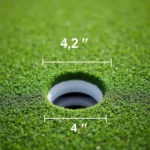Golf is a sport that blends skill, strategy, and a deep appreciation for nature. However, one element of nature can make or break your game: wind. Learning to play in various conditions is part of becoming a more well-rounded golfer, but at what point does wind make playing impossible or even dangerous?
In this guide, we’ll explore the impact of wind on golfing conditions, how to assess when it becomes too windy, and tips on how to adjust your game accordingly. So grab your clubs and let’s dive in!
Understanding Wind and Golf
Wind is a fundamental factor in golf. As anyone who has played knows, it can affect the trajectory, distance, and accuracy of your shots. For instance, a gentle breeze can help carry a well-struck ball further, but strong gusts can completely alter its path.
How Wind Affects the Game
- Trajectory: Golf balls are designed to be aerodynamic. Wind can lift a shot or push it sideways, leading to frustrating hooks or slices.
- Distance: Depending on the direction, wind can either add or subtract from your distance. A headwind can make it tough to reach the green, while a tailwind may push your ball farther than intended.
- Putting: Wind can disturb the greens, affecting your ability to putt accurately. A windy day might make even short putts feel like a challenge.
Wind Speed Categories
- Calm (0-5 mph): Perfect conditions for golf. You can play without worrying about the wind affecting your shots.
- Light Breeze (5-10 mph): Still manageable, though adjustments may be needed for longer shots. This is typically the ideal wind speed for most golfers.
- Moderate Breeze (10-15 mph): Players will notice the effect of wind, requiring intentional adjustments on approach shots. Wind direction becomes an important consideration.
- Fresh Breeze (15-25 mph): Playing becomes considerably more challenging. Total concentration is required to adjust for wind.
- Strong Gale (25+ mph): At this level, most players will find it frustrating. Shots curve significantly, and precision putting becomes nearly impossible.
 Golf course on a windy day
Golf course on a windy day
The “Too Windy” Benchmark
Generally speaking, any sustained wind over 20 mph can drastically alter playability and enjoyment. Here’s a breakdown to help you gauge your conditions:
| Wind Speed | Effects on Golf | Playability |
|---|---|---|
| 0-5 mph | Minimal effect; ideal conditions | Excellent |
| 5-10 mph | Slight adjustments needed; manageable | Good |
| 10-15 mph | Noticeable impact on longer shots | Acceptable with caution |
| 15-20 mph | Players must adjust shots significantly | Challenging, but doable |
| 20-25 mph | Difficult conditions; frustration likely | Consider suspending play |
| 25+ mph | Unplayable for most golfers | Recommend waiting for better weather |
When winds reach 25 mph or higher, it’s typically considered too windy for most players. This is especially true if gusts are inconsistent, as they can lead to unpredictable outcomes that interfere with the enjoyment of the game.
Strategies for Playing in Windy Conditions
If you find yourself on the course when the wind picks up, don’t fret! Here are some valuable tips to help stabilize your game:
Adjust Your Shots
- Lower Trajectories: Keep your shots lower to the ground. Opt for less lofted clubs, which can help minimize the impact of wind.
- Weight Your Shots: Focus on a more solid stance and weight transfer. This helps in maintaining control amid stronger winds.
- Swing Smoothly: Avoid trying to hit harder. Instead of swinging for maximum power, swing smoother and more controlled for better accuracy.
 Golfer adjusting their stance in the wind
Golfer adjusting their stance in the wind
Play Smart
- Stay Centered: Remain committed to your target but ready to adjust. Keep your focus on the green, and don’t let the wind distract you.
- Club Selection: Don’t hesitate to use a stronger club than usual, especially for longer shots, to counteract wind resistance.
Mental Game
- Stay Positive: Remember that everyone else is dealing with the same environmental challenges. Focusing on staying positive will keep your mindset in check.
- Adjust Your Strategy: Accept that you may need to change your game plan based on the wind conditions. Be adaptable and patient.
Key Takeaways
- Ideal Conditions: Wind speed under 10 mph is optimal for golf play.
- Danger Zone: Generally, wind speeds over 25 mph make play difficult or unplayable for most golfers.
- Adjustments Needed: When faced with wind, modify clubs, shots, and mindset to maintain focus and positivity regarding the game.
Frequently Asked Questions
1. What is the best score for playing in windy conditions?
- A personal best score is relative, but many golfers see higher scores when winds exceed 20 mph. Focus on playing to your strengths on windy days.
2. Is it safe to play golf in high winds?
- In strong winds (25+ mph), safety can be a concern. Ensure to monitor surrounding areas, especially for falling branches or flying debris.
3. How do professional golfers handle windy conditions?
- Professionals typically rely on their experience, adjusting club selection, shot trajectory, and strategic course management to adapt and thrive.
 Professional golfer taking a shot in windy conditions
Professional golfer taking a shot in windy conditions
4. How can I practice for windy conditions?
- Simulate conditions on calm days by practicing lower trajectory shots and varying your club selections. Consider using practice ranges that allow for exposure to wind.
5. Can wind affect putting speed?
- Yes! Strong wind can change the putting surface conditions and can add extra difficulty to distance control.
6. Should I skip golf if it’s windy?
- While some may enjoy the challenge, if winds exceed 25 mph, it might be best to postpone for safety and enjoyment.
7. Are there specific golf courses better suited for windy days?
- Yes! Coastal golf courses often have designs that accommodate windy conditions, usually with large greens and fewer obstacles.
8. How does wind influence golf ball technology?
- Golf ball designers consider wind resistance when creating balls. Many modern balls are engineered to minimize wind impact.
Whether you’re a seasoned golfer or just picking up the sport, understanding how wind affects your game is crucial. Remember, while wind can add a layer of challenge to your rounds, it can also offer a unique opportunity to enhance your skills. Embrace the winds, adapt, and continue to enjoy this beautiful game!
For more insights on golf, don’t forget to check out our other articles here.

